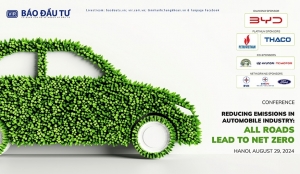EV strategy must prioritise keeping the pace globally
 |
| Dao Cong Quyet, representative, Vietnam Automobile Manufacturers’ Association |
The Vietnamese vehicle market is poised for significant growth as incomes reach the motorisation threshold of $3,000 per capita and above, coupled with a large population. However, vehicle sales and production in 2023 showed a marked decline compared to previous years.
Last year, over 177,000 vehicles were produced, a sharp drop from over 232,000 units in 2022, and lower than figures from 2016-2018. Total sales in 2023 reached nearly 302,000 units, much lower than the 404,600 sold in 2022 and less than in 2021, 2019, and 2016.
Vietnam’s vehicle industry is currently in a maintenance phase and urgently needs state policies on taxes and fees to support and encourage growth. These policies would help expand market capacity, develop the supporting industry, and narrow the cost gap between completely knocked down and completely built-up units, which currently stands at 10-20 per cent of manufacturing costs. These steps are essential for transitioning the industry to a growth phase.
A significant challenge for the Vietnamese auto industry is its small market and production scale, which is only half that of Thailand and one-third of Indonesia. This limited scale presents difficulties in developing a robust supply chain.
EVs are becoming a global trend, including in Vietnam. As the country transitions, the development of infrastructure – particularly charging stations – is critical. A widespread, cost-effective network of stations that supports various vehicle models is essential.
In developed countries like Norway and Denmark, establishing a charging station network is seen as a prerequisite for advancing EVs. These countries have implemented strategic support measures to encourage the installation and use of such stations.
For example, the Norwegian government covers up to 100 per cent of installation costs for fast-charging stations and conducts public bidding to set fees for every 50 km of stations. Similarly, Denmark supports home charging installations, offers tax reductions on electricity used, and subsidises the costs of private stations.
However, focusing on the number of charging stations is not enough. Their quality and strategic distribution are equally important in the transition to EVs. In 2020, the cost of producing a high-quality EV was 45 per cent higher than that of an internal combustion engine vehicle, but this gap is expected to narrow to just 9 per cent by 2030 due to reductions in the cost of components like batteries, exteriors, and assembly processes, making EVs more accessible.
In Vietnam, the majority of households are unable to install home charging stations, highlighting the urgent need to develop a network of public stations. The country needs a comprehensive plan for a nationwide system, particularly in major cities and along highways. Policies to support investment in building stations and incentives for related equipment manufacturers must be established and implemented cohesively.
In countries where EVs have gained traction, governments have provided strong support to encourage their adoption. Germany in Europe, the US in the Americas, and Japan in Asia have already introduced tax incentives, reduced registration fees, and offered incentives for company cars and vehicle purchases.
In Southeast Asia, Thailand and Indonesia offer additional incentives, such as applying a CO2 tax for EVs and providing significant price reductions with favourable interest rates. In Vietnam, current incentives apply only to fully EVs, including reductions in excise taxes and exemptions or reductions in registration fees. Plug-in hybrids receive partial excise tax support, equivalent to 70 per cent of that for internal combustion engine vehicles, with no plans for incentives for hybrid vehicles.
The Vietnam Automobile Manufacturers’ Association supports the government’s policy to implement related commitments. In order to achieve these goals, the government needs to issue specific policies and action plans, following a roadmap suited to the country’s socioeconomic development and the conditions of the vehicle industry, while also drawing on international experience.
Key policy areas impacting the development of the vehicle industry include the strategy for developing the vehicle industry, infrastructure and green energy; tax and fee policies (including a special consumption tax and registration fees); environmental protection policies; testing and certification; and standards and regulations for EVs and charging stations.
We propose updating the Strategy for the Development of the Vietnamese Automobile Industry to align with new trends. The strategic goal should prioritise the development of the industry in Vietnam, keeping pace with global trends in electrification and EVs.
 | Supporting a green strategy for the automotive industry With 6.5 million cars and 74 million motorcycles, Vietnam is the second-largest emitter of greenhouse gases (GHGs) from road transport in Southeast Asia, following Indonesia. Emissions from road vehicles in the country are rising rapidly, with an average annual increase of about 15 per cent over the past decade. |
What the stars mean:
★ Poor ★ ★ Promising ★★★ Good ★★★★ Very good ★★★★★ Exceptional
Related Contents
Latest News
More News
- Main drivers for Vietnam’s digital economy future (December 03, 2025 | 11:35)
- Pivotal stage of growth paves way for rise in M&As (December 03, 2025 | 10:00)
- Positive projections for M&A interest from Thailand (December 03, 2025 | 09:40)
- Manifesting the first line of defence in cybersecurity (December 03, 2025 | 09:00)
- The transformational role AI can play in accounting arena (December 03, 2025 | 08:00)
- Unlocking 5G-AI potential in Singapore (December 03, 2025 | 08:00)
- Data-driven strategies vital for a fast-evolving nation (December 02, 2025 | 09:41)
- Policy to practice: how Vietnam can lead the region (November 26, 2025 | 16:03)
- Mobilising private capital at scale vital for climate battle (November 26, 2025 | 15:36)
- VILAF and Yoon & Yang launch Vietnam - Korea Practice Unit (November 26, 2025 | 15:16)

 Tag:
Tag:




















 Mobile Version
Mobile Version